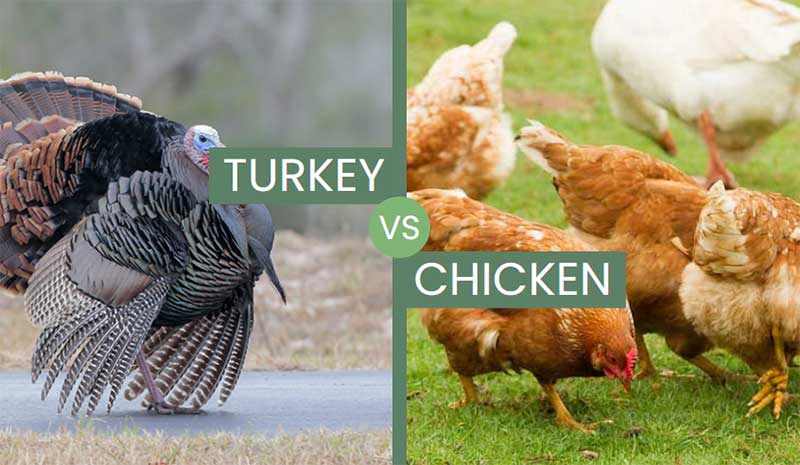Turkey vs chicken – do you know the difference? A chicken clucks, a turkey gobbles, and they look very different from each other. However, they’re not completely different. Both chickens and turkeys feed off the ground, are heavy-bodied, and are from the same family, Phasianidae.
In this article, we’ll go over everything you need to know about these two birds to help you understand their similarities and differences.
On this page
Body & Shape
Turkeys and chickens are opposites in almost every way. However, they have one very notable similarity. Both turkeys and chickens have wattles. Wattles are the flaps of skin that hang on either side of a chicken’s throat, just behind the beak. Wattles help chickens and turkeys release excess heat.
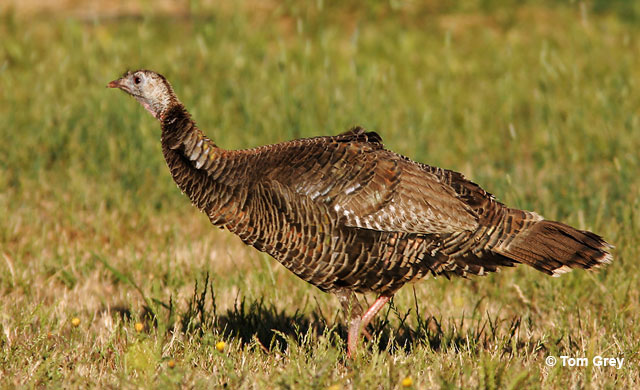
© Tom Grey
Additionally, chickens have more colorful feathers in comparison to turkeys. Male chickens are usually brighter than female chickens.
Turkeys have darker plumage, a snood over their head, and a featherless neck and head. Male turkeys are more colorful than female turkeys.
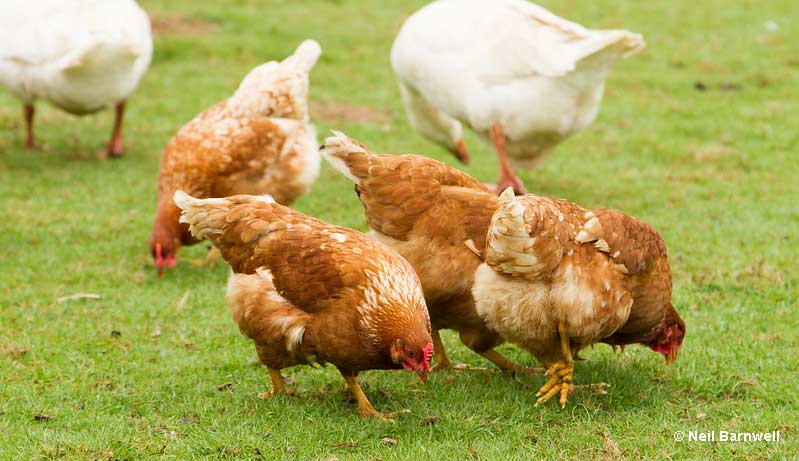
© Neil Barnwell
Turkey vs Chicken Size
Chickens tend to be smaller than turkeys; they can reach a length of up to 2.3 feet and weigh around 5.5 pounds. Hens can be anywhere from 14 to 20 inches tall and roosters can be anywhere from 20 to 26 inches tall.
Turkeys, on the other hand, are larger. Wild and domesticated turkeys are known for their sheer size. They can reach a length anywhere from 3.3 to 4.1 feet and weigh around 24 pounds.
Speed
Turkeys can fly and have been known to fly short distances, up to a 1/4 of a mile. They can fly at high speeds of anywhere from 40 to 55 mph. These birds have to fly because they roost in trees at night, but they spend the majority of their time on the ground.
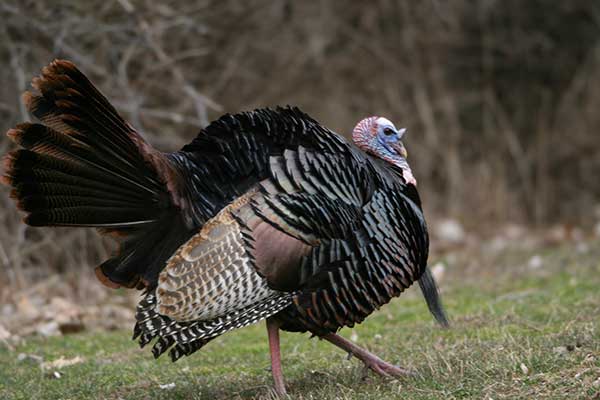
Like turkeys, chickens can fly but are not very good at it. They can’t fly very far and can’t fly very high, but they can fly.
If given a chance, chickens will test their wings from the moment they develop their flight feathers from 5 to 10 weeks. It’s unclear how fast chickens can fly, but they can run at speeds of 9 mph.
These birds fly for the sole purpose of survival. They’re descendants of wild jungle fowl of Asia. They used their wings to roost in trees at night and escape predators. The farthest recorded distance of a chicken in flight was 301.5 feet. The longest recorded flight of a chicken was 13 seconds.
Age
On average, turkeys live longer than chickens. The average lifespan of a wild turkey is 3 to 5 years. The average lifespan of domestic turkeys is 10 years old.
Chickens are trickier when it comes to their lifespan because their average lifespan is more broad. Most roosters live to be anywhere from 5 to 9 years old, while hens live to be anywhere from 3 to 7 years old.
Turkey vs Chicken Behavior
Both turkeys and chickens can be very friendly and loving birds. But, each bird will have their own individual and unique personality. However, as a whole, turkeys tend to have different behaviors to each other, while chickens tend to have similar behaviors to each other.
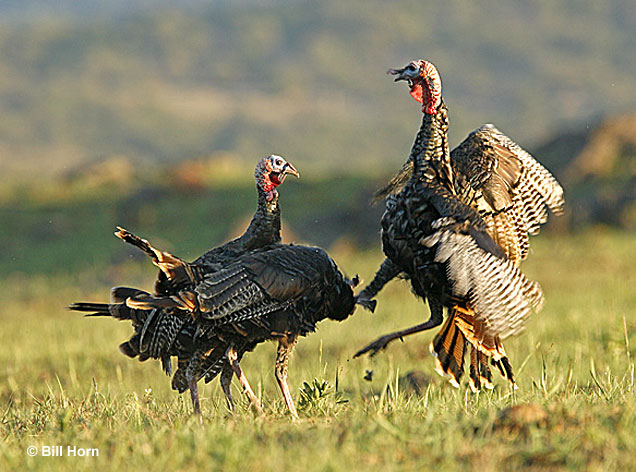
When paired together, it’s obvious that turkeys are slower than chickens and tend to be followers more than leaders. Additioanlly, turkeys are more deliberate in their actions than chickens and are less skittish overall.
Turkeys are said to be friendlier and “dog-like.” They’re known to follow people around and constantly want pets. Don’t get us wrong, some chickens are also like this, but they tend to have shorter attention spans.
It’s uncommon, but turkeys have been known to try and attack or dominate people they view as subordinates. This behavior mainly occurs when it’s breeding season.
Chickens are not known to be aggressive, but some breeds are more aggressive and can pose a threat to both other animals and people.
Turkey vs Chicken Diet
Wild turkeys consume plant matter on the ground or in low trees and shrubs. They’ll scratch at the forest floor for acorns, beech nuts, pecans, and other seeds and berries in the fall, winter, and early spring.
When large amounts of snow cover the ground, these birds eat evergreen ferns, hemlock buds, and club mosses. In late spring and summer, turkeys in the wild will strip seeds from grasses and sedges.
They’ll occasionally supplement their diet with snails, salamanders, and insects.
Domesticated turkeys are fed commercial turkey feed. However, when roaming free, they will consume insects and can be given various treats. Some of the treats that can be given to domestic turkeys include:
- Cabbage
- Kale
- Cucumber
- Squash
- Zucchini
- Cooked sweet potato
- Blueberries
- Strawberries
- Craisins or raisins
- Watermelon
- Peeled banana
High-quality commercial feed should be the main food source for domestic chickens. This way, you can ensure they get all the nutrients they need.
These feeds are made up of grains, grit, and vitamins. Various fresh vegetables and fruits can also be given to supplement their diets. Examples of foods that can be fed to the chickens include:
- Vegetable peels
- Apples
- Bananas
- Berries
- Spinach
- Carrots
- Broccoli
- Cabbage
- Cooked pasta
- Cooked beans
Chicken feed should never be substituted for turkey feed and vice versa. These birds have very different nutritional requirements. This is especially true when it comes to calcium and protein. Also, turkeys are much larger than chickens, so they need more food. In their first 6 weeks of life, turkeys should consume 28% protein feed. That’s a big difference from your standard chick, which consumes 18 to 20% protein feed.
Location
Wild Turkeys can be found in isolated pockets of the western U.S. states, the eastern portions of the United States, extreme southern Canada, and south to northern Mexico.
These birds live in open forests with interspersed clearings year-round. Birds in the northeastern portions of the U.S. use mature oak-hickory and humid forests. In the southeastern portions of the U.S., turkeys live in forests containing pine, beech, and oak trees.

© Neil Barnwell
Domestic chickens can live pretty much everywhere, they only need coops. It’s essential that you have the right amount of space for how many chickens you have.
Related: What is a group of chickens called?
For example, one medium-sized chicken needs a minimum of 8 to 10 square feet outdoors and 3 square feet of floor space inside the coop. Whether you let your chickens run around your backyard or keep them in a large coop, the area they’re in must be fenced to keep the chickens safe.
Nest & Eggs
Wild Turkeys make their nests on the ground at the bases of trees in dead leaves, open hayfields, under brush piles, or in thick shrubbery. The female turkey scratches a depression into the soil around 9 to 13 inches long, 8 to 11 inches wide, and 1 inch deep.
Learn more: Baby Turkey Facts & Lifecycle
Wild Turkeys generally have one brood per breeding season, laying up to 17 eggs. Domesticated turkeys, on the other hand, can lay up to 2 eggs per week.

Turkey eggs are a bit larger than chicken eggs and a bit different in color. © Jason Hollinger
Chickens build their nests in nesting boxes. Nests are often made from shredded paper, sawdust, or wood shavings. The ideal size for a nesting box is 12 x 12 x 12; this will give hens more than enough room to lay their eggs.
Wild chickens can have up to 3 broods per breeding season, the clutch size can range from 10 to 14 eggs. Domesticated chickens generally lay one egg per day if their living conditions are good.
Turkey vs Chicken: Frequently Asked Questions
Is it easier to raise turkeys or chickens?
Chickens are a little bit easier to raise than turkeys. However, with a few minor adjustments, raising turkeys is pretty close to raising chickens. However, raising them as babies is more energy and time-intensive than raising baby chickens.
Are turkeys more friendly than chickens?
Yes, turkeys are friendlier than chickens! They’re funny, curious, easy-going, and known to be “dog-like.” They’ll watch your every move and even follow you around.
Can turkeys and chickens live together?
Some people raise turkeys and chickens together and have success; however, it’s not recommended. Keeping your birds healthy is essential, and turkeys and chickens can pass diseases like blackhead. Turkeys are highly susceptible to blackhead, while chickens are not.
Can turkeys lay eggs like chickens?
Like chickens, turkeys lay eggs. However, they lay them less frequently and don’t start laying as early as chickens do. Turkeys lay around 100 eggs yearly; chickens lay around 300 eggs yearly. Additionally, turkeys begin laying at about 7 months old, and chickens start laying at about 5 months old.

